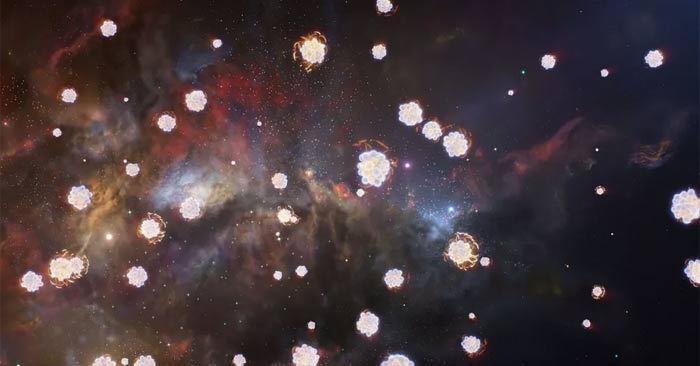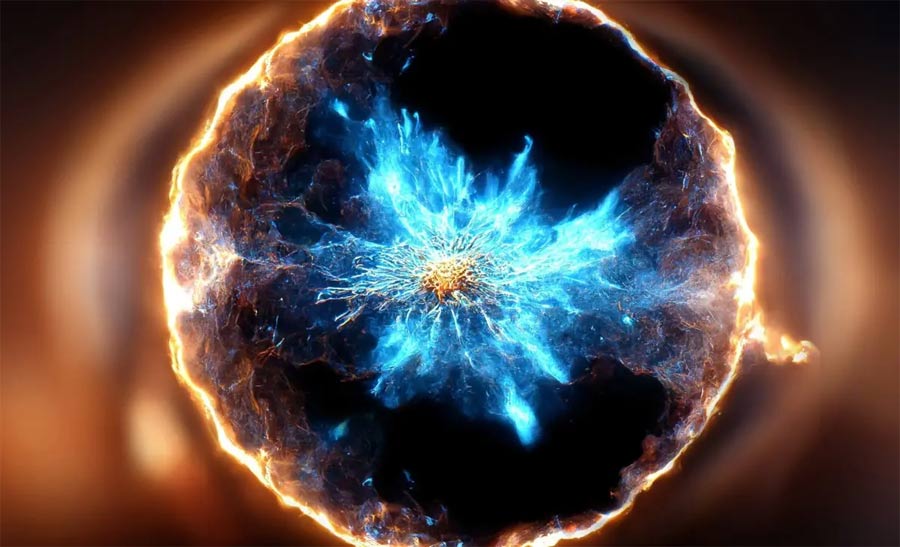Water in the Universe May Have Formed Closer to the Big Bang Than Previously Thought
Everyone knows there is water in the universe, but you might be surprised to learn that it appeared much earlier than expected, especially near the Big Bang.

When did life as we know it first appear in the universe?
We don't know for sure, but the answer is closely tied to when water first appeared in the universe—and new simulations suggest that the first generation of stars that helped form such life-giving water occurred just 100 million to 200 million years after the Big Bang. That pushes back previous estimates by more than 500 million years.
The findings suggest that if some of this early water survived the 'hot' chaos of early galaxy formation, it could have been absorbed into newborn planets, potentially leading to habitable worlds with abundant water just a few hundred million years after the Big Bang. It all has implications for the story of how early life may have begun in the universe.
Previous observations from the Atacama Large Millimeter/submillimeter Array (ALMA) in Chile showed that water existed about 780 million years after the Big Bang, when the young universe was filled with light hydrogen and helium, along with small amounts of lithium. These elements formed the first generation of stars, known to astronomers as Population III stars, which were very massive—tens or even hundreds of times the mass of our sun—and had considerable lifespans before dying as supernovae. Many of the universe's heavier elements, including oxygen, were formed inside these stars through nuclear reactions and were distributed into space when they died, where they were then incorporated into the next generation of stars.
To determine when the first water formed in the universe, the team used numerical models to track the lives of two early-generation stars: one 13 times more massive than our Sun and the other 200 times more massive. The smaller simulated star lasted 12.2 million years before dying in a supernova explosion, releasing about 0.051 solar masses of oxygen (nearly 17,000 Earth masses) into the surrounding space. The larger simulated star burned through its fuel for just 2.6 million years before meeting its explosive end, releasing 55 solar masses of oxygen (more than 18 million Earth masses) into space.
Simulations show that as the shock waves from each supernova radiate outward, turbulent density fluctuations create ripples that cause some of the gas to condense into dense clumps. These leftover clumps, enriched in metals including oxygen ejected by the supernova, were likely prime sites for water to form throughout the early universe.

Located in the denser parts of the cloud, the water would be protected from being destroyed by the harsh radiation from nearby stars. However, the team considered the simplest case, with only one star forming in each cluster, while theoretical simulations show that multiple star systems are the norm; more than half of the stars in the sky have one or more sibling stars. More nearby stars would mean denser, more water-rich clusters, but also more radiation.
These are the first questions that space scientists are trying to answer, but they need more people to dig deeper into this topic and explore it in more detail.
You should read it
- Top 4 best selling hot and cold water plants today
- Top 5 best water toothpick machines today
- 5 things to remember when using hot and cold water plants
- Water will become 'poison' if taken at 5 times later
- Get water into your ear after swimming properly according to expert's instructions
- What is the best RO water purifier?
 Dark Energy: New Discovery Turns Our Understanding of the Universe Into Over
Dark Energy: New Discovery Turns Our Understanding of the Universe Into Over The most distant galaxy ever discovered holds amazing secrets
The most distant galaxy ever discovered holds amazing secrets Traces of a meteorite impact that shook the Earth 600 million years ago have been found
Traces of a meteorite impact that shook the Earth 600 million years ago have been found Largest 'super-Earth' ever discovered, 200 light years away
Largest 'super-Earth' ever discovered, 200 light years away The mysterious history of black holes has been decoded by scientists
The mysterious history of black holes has been decoded by scientists Admire the rare and beautiful 'astronomical ring' of the universe
Admire the rare and beautiful 'astronomical ring' of the universe